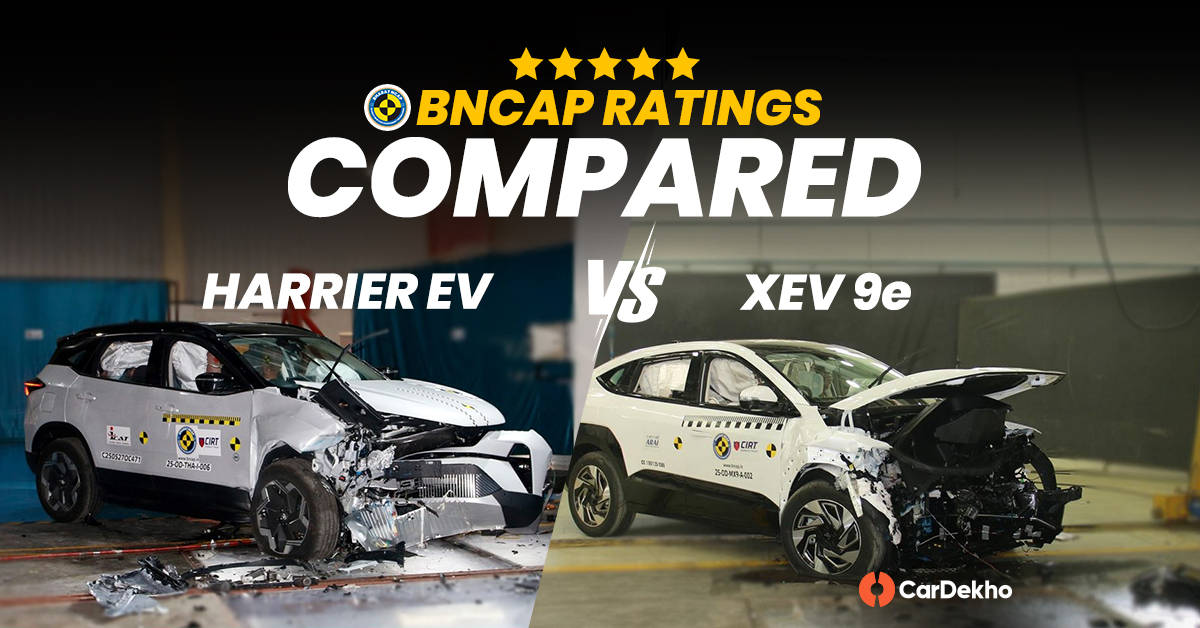2025 Tata Harrier EV vs Mahindra XEV 9e: Bharat NCAP Ratings Compared
Modified On Jun 25, 2025 05:23 PM By Dipan
- Write a comment
The Harrier EV and XEV 9e are the flagship EVs from the Indian carmakers and both have earned a 5-star safety rating in their respective BNCAP tests
After the rear-wheel-drive (RWD) variants of the Tata Harrier EV were launched recently, the flagship Tata EV was crash tested by Bharat NCAP, where it scored a 5-star safety rating. Notably, its prime rival, the Mahindra XEV 9e has also scored a 5-star crash safety rating from its Bharat NCAP test in January 2025. So, which amongst the two EVs is the safer option? Let us find out.
Bharat NCAP Crash Test Results And Scores
| Parameters |
Tata Harrier EV |
Mahindra XEV 9e |
| Adult Occupant Protection (AOP) score |
32/32 points |
32/32 points |
| Adult safety rating |
⭐⭐⭐⭐⭐ |
⭐⭐⭐⭐⭐ |
| Frontal Offset Deformable Barrier Test score |
16/16 points |
16/16 points |
| Side Movable Deformable Barrier Test score |
16/16 points |
16/16 points |
| Child Occupant Protection (COP) score |
45/49 points |
45/49 points |
| Child safety rating |
⭐⭐⭐⭐⭐ |
⭐⭐⭐⭐⭐ |
| Child safety dynamic score |
24/24 points |
24/24 points |
| CRS installation score |
12/12 points |
12/12 points |
| Vehicle assessment score |
9/13 points |
9/13 points |
Let us not take a detailed look at how both EVs performed in their respective Bharat NCAP crash tests:
Performance of both EVs at Bharat NCAP
(Click image for more details)
As seen in the above table, both the EVs have performed phenomenally well in the crash tests and have the exact same scores. They earned a ‘good’ rating for all body parts in their frontal offset deformable barrier test, for both the driver and co-driver. In the side movable deformable barrier test and side pole impact tests too, all parts of the occupant received ‘good’ protection. All of this helped both EVs to score 32/32 points in their AOP tests.


(Click image for more details)
In COP, while both rivals fetched full points in both the frontal (8 out of 8) and side (4 out 4 points) crash tests for the 18-month-old and 3-year-old dummies. However, they lost some marks in the vehicle assessment criteria, which brought down the COP scores to 45 out of a total 49.


(Click image for more details)
This means that regardless of the car you choose, their strong safety rating should ensure maximum protection for occupants in case of an unfortunate event.
Safety Features
The safety suite of both EVs is similar too with amenities such as 7 airbags (6 as standard), front and rear parking sensors, a 360-degree camera with blind spot monitor, an electronic parking brake with auto hold function and a tyre pressure monitoring system (TPMS). Both EVs also get a level 2 advanced driver assistance systems (ADAS) suite with features such as adaptive cruise control and driver attention warning. Moreover, the Tata Harrier EV is equipped with a digital inside rearview mirror (IRVM) that doubles up as a dashcam, while the XEV 9e gets a regular dashcam.
Price And Rivals
Tata Motors has revealed the prices of only the rear-wheel-drive variants of the Harrier EV. Let us take a look at how these prices compare against the Mahindra XEV 9e:
| Model |
Price Range |
| Tata Harrier EV (introductory prices of RWD variants only) |
Rs 21.49 lakh to Rs 27.49 lakh |
| Mahindra XEV 9e |
Rs 21.90 lakh to Rs 30.50 lakh |
All prices are ex-showroom, pan-India
Both the Tata Harrier EV and Mahindra XEV 9e lock horns with the BYD Atto 3.
Follow the CarDekho WhatsApp channel to get instant updates from the automotive world.
1 out of 1 found this helpful
















